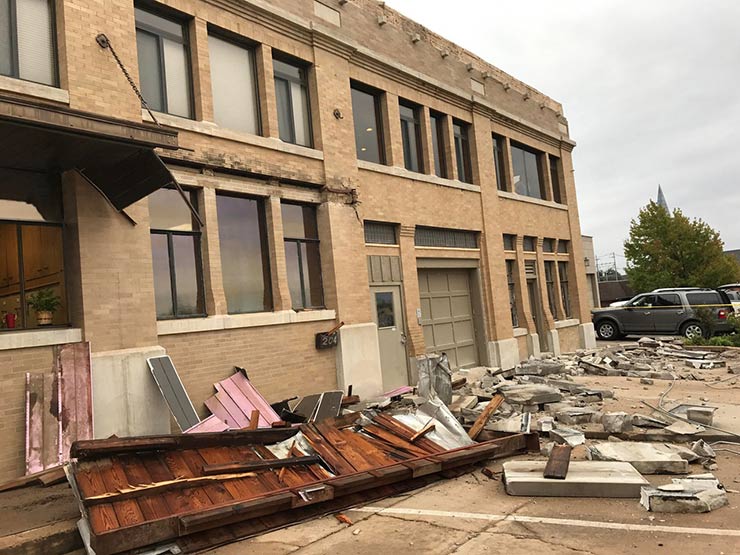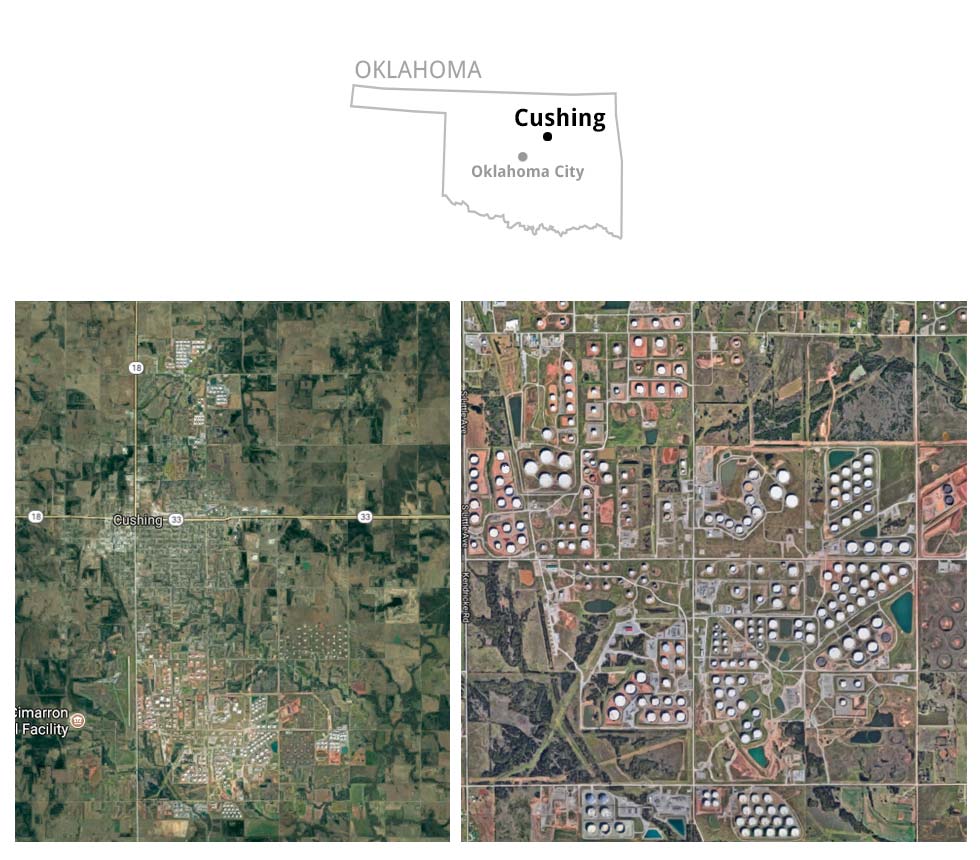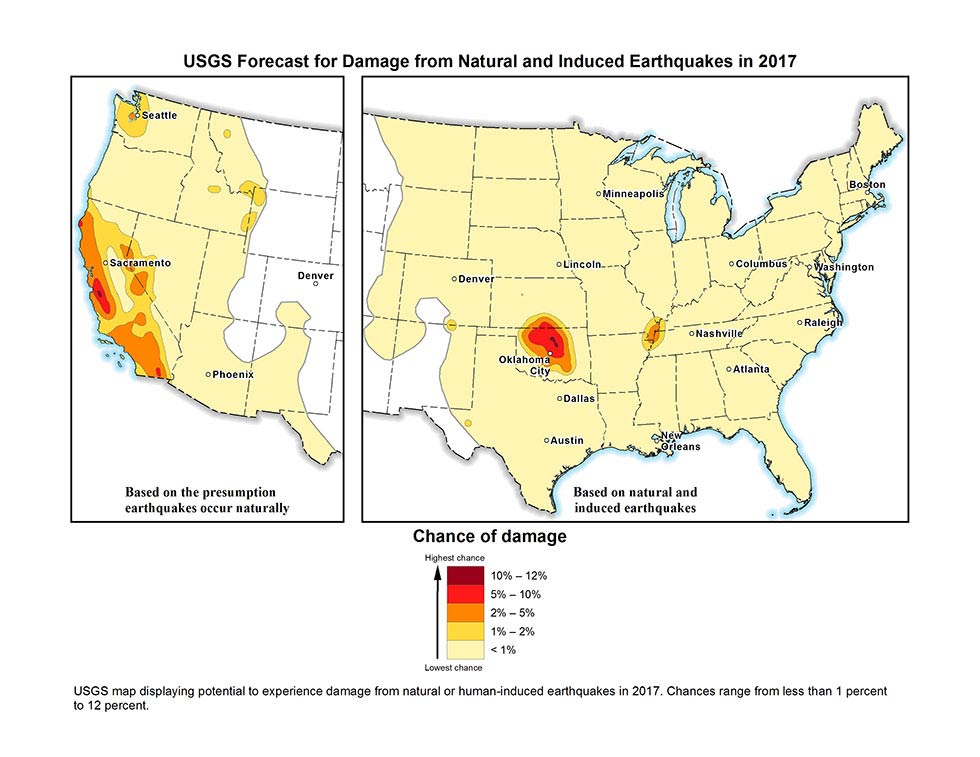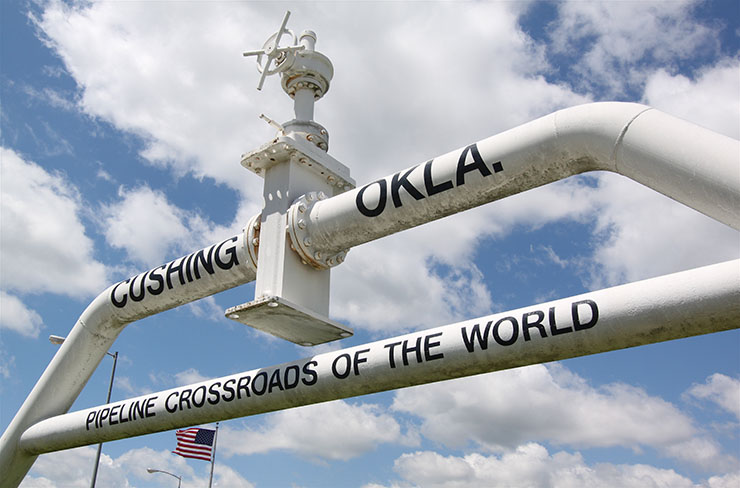The Fragile Ground Beneath 66 Million Barrels of Oil

Abigail Malate, Staff Illustrator
Copyright American Institute of Physics (reprinting information)
(Inside Science) -- Three miles below the town of Cushing, Oklahoma, tectonic forces squeeze the rock with a pressure of more than 7,000 pounds per square inch. For years now, wastewater pumped underground as part of oil and gas development has seeped into natural cracks in that rock, easing the friction that keeps it stuck in place. Perched directly overhead is a community of 8,000 people -- and one of the largest oil storage facilities in the world.
So far, the Cushing Tank Farm, also known as the Cushing Hub, has withstood the earthquakes that have rattled the region for the past few years, the majority of which are believed to be caused by wastewater from fossil fuel production. The town itself has not fared as well. While its residents have escaped serious injury, many of its historic buildings suffered damage during a magnitude 5.0 earthquake that struck in November 2016, with an epicenter less than two miles west of town.
"It shook this building like a rag doll," said David Reid, who runs the local newspaper out of the same 1922 yellow brick building where he lives with his wife, the newspaper's accountant. "With the crashing and the shaking and the noise," said Reid, "I just didn't know how we were going to get out of here." The noise turned out to be around 15 tons of sculpted limestone crashing to the sidewalk, said Reid, who is one of several residents now suing the companies that have injected wastewater nearby.

Damage to David Reid's historic building sustained during the magnitude 5.0 Cushing earthquake in 2016.
Credit: David Reid
Researchers debate how much danger Cushing's people and its 66 million barrels of stored oil are still in. Since Cushing suffered its first major barrage of earthquakes in 2014, state regulators have dramatically cut the amount of wastewater being pumped into nearby bedrock, and their efforts do seem to be reducing the frequency of earthquakes.
But even if all wastewater injection stopped today, the amount already injected could still trigger larger earthquakes in the future, according to researchers. This past April at the Seismological Society of America meeting in Denver, Colorado, Art McGarr, a seismologist with the U.S. Geological Survey in Menlo Park, California, estimated that Cushing could experience an earthquake as large as magnitude 5.6 -- large enough to cause damage to structures within about 12 miles, he said. Daniel McNamara, a USGS seismologist based in Golden, Colorado, placed that number even higher, speculating that Cushing could see earthquakes as large as 6.5 -- larger than the 6.0 "South Napa" earthquake that injured an estimated 200 people and caused around $500 million of damage in Northern California in 2014. Earthquake magnitude is a logarithmic scale, so a magnitude 6 is 10 times as large as a magnitude 5.
While some seismologists view such statements regarding potential earthquake magnitudes as alarmist, all those contacted by Inside Science agreed on one thing: When energy companies inject wastewater, they have no reliable way of knowing whether their actions will cause earthquakes, when those earthquakes may strike or how large they may be. Recent technological advances for extracting fossil fuels have outpaced our ability to predict how the Earth will respond.
"Nobody's got a predictive tool that will tell me, 'This is the place that is at largest risk,'" said Jeremy Boak, director of the Oklahoma Geological Survey at the University of Oklahoma in Norman. Even the most sophisticated hydrologic models developed to date, he said, can only give "a kind of impression of what's going on."
Earth-shaking technologies
Within the last 10 years, advances in technology for extracting fossil fuels have facilitated an energy boom in North America, one side effect of which has been an increase in the number of earthquakes in traditionally stable areas. Oklahoma has gotten the worst of it, averaging more than 700 earthquakes per year of magnitude 3 or greater over the last three years -- compared with just one per year from 1974 to 2008.
"You talk to Oklahomans and everybody has a tornado story, primarily. But now, everybody also has an earthquake story," said Jake Walter, state seismologist with the Oklahoma Geological Survey at the University of Oklahoma.
One of the most important advances for the oil and gas industry has been the maturation and improvement of technology for "horizontal drilling" -- the ability to drill L-shaped wells that bend sideways after reaching the appropriate depth. Horizontal drilling is often combined with the older technique of hydraulic fracturing, or "fracking," which uses high-pressure water to crack rock and release oil that would otherwise be trapped inside.
The sudden injections used in fracking can trigger earthquakes, but contrary to popular belief, they are not the main cause of induced earthquakes in the central United States, said David Eaton, a seismologist at the University of Calgary in Canada who specializes in fracking-induced earthquakes. Moreover, earthquakes caused by the process of fracking itself tend to be relatively small; to the best of Eaton's knowledge, none so far have caused injuries or property damage.
The bulk of induced earthquakes in the central U.S. are instead caused by efforts to get rid of wastewater, a byproduct of several types of fossil fuel extraction including fracking. Only a small minority of wastewater disposal projects ever trigger earthquakes, noted McGarr. But with an estimated 21.2 billion barrels of wastewater produced in the U.S. in 2012 alone, even a small risk can add up to a lot of extra shaking.
In Oklahoma's case, about 90 percent of wastewater comes not from fracking, but from naturally watery oil deposits, said Matt Skinner, a spokesperson for the Oklahoma Corporation Commission, the state agency that regulates oil and gas development. Horizontal drilling has enabled energy companies to access these deposits easily. Since around 2009, companies have rapidly pumped out the contents of the watery deposits, then separated out the oil from the much larger volumes of salty, toxic wastewater.
"The most economical way to deal with the wastewater is to inject it deep underground to a permeable formation that has a lot of porosity, and then hope never to hear from it again," said McGarr. The permeable rock acts like a sponge.
In 2015 alone, energy companies in Oklahoma had to dispose of about 1.5 billion barrels of wastewater, enough to fill more than 95,000 Olympic swimming pools, according to Boak, the director of the Oklahoma Geological Survey.
Most of Oklahoma's wastewaster has been injected into the Arbuckle formation, a layer of sedimentary rock about 7,000 feet below the surface. The Arbuckle is a tempting place to dump waste because it can easily absorb huge amounts of water without leaking into drinking water, said Skinner.
But the Arbuckle formation sits right on top of the crystalline basement, the deep, ancient rock layer where most wastewater-induced earthquakes originate. The crystalline basement is laced with highly pressurized faults, and wastewater seeps down from the Arbuckle into those faults. And water can greatly affect a fault.
"[Wastewater] lubricates it, in effect. Allows it to slip more easily, and that results often in fairly large earthquakes," said McGarr.
Once a system of interconnected faults start to move, it may not settle down again for a long time, he added. Earthquakes ease the pressure along a particular stretch of fault, but they transfer that pressure to adjacent areas, potentially triggering a swarm of earthquakes nearby.
Blind injection
People have known for decades that that it's possible to trigger earthquakes by injecting water underground, but until recently, the phenomenon was rare and little studied. Now, researchers are working furiously to understand it.
"Because it's a research topic really in progress, we don't have a definitive answer for the causes of induced seismicity," said Cristiano Collettini, a geophysical scientist at the Sapienza University of Rome in Italy.
Collettini's team recently developed a laboratory instrument capable of mimicking induced earthquakes by injecting water into a tiny fault two inches across. The instrument provides some clues about the mechanisms involved, but in the real world it remains difficult to determine things like where water will end up as it flows through the rock, or how much pressure it will exert when it gets there, said Collettini.
In many cases, people don't even know where the faults are until they start to slide. Energy companies and researchers can see some of what's happening underground using seismic reflection, a process that sends sound waves into the rock and measures how long they take to bounce back. This technique can reveal faults that have already slid around, placing different types of rock against each other. But more subtle faults are often invisible.
"Less than 12 percent of the earthquakes we have occur within two kilometers of a mapped, optimally oriented fault," said Boak. "We really don't know a lot about the fault systems on which many of these earthquakes are happening."
Even when the faults are known, it's not clear how large an earthquake they could produce. In general, the larger the fault, the larger the possible earthquake. But a fault could extend beyond the region that has been mapped, said Boak.
For induced earthquakes, the magnitude may also depend on the volume of wastewater, according to McGarr. The analysis he presented in April suggests that several of Oklahoma's recent earthquakes were of the maximum magnitude one would expect, based on the amount of wastewater injected nearby. Cushing was the exception, with conditions ripe for an earthquake as large as 5.6.
Other researchers are skeptical of McGarr's approach and unwilling to place any upper limits on earthquake magnitude in Cushing or elsewhere. The largest earthquake ever recorded in the state was a 5.8 that struck in September 2016, about 25 miles north of Cushing near a town called Pawnee.
"I'm hesitant to say that we have a good idea of what the maximum earthquake could be in this region," said Boak.

Left: A satellite image shows the town of Cushing just north of the Cushing oil storage facilities. Right: Round tanks used to store crude oil are visible in a zoomed-in version of the same satellite image.
Credit: Satellite image composite by Abigail Malate, Staff Illustrator (Copyright American Institute of Physics)
Wastewater injection and response
At first, Oklahoma regulators took a piecemeal approach to their new earthquake problem, focusing only on those wells that were closest to past epicenters, said Skinner. But shaking continued to increase throughout a broad swathe of north-central Oklahoma. In 2015, he said, the regulators adopted a new strategy aimed at reducing the overall amount of wastewater injected into the Arbuckle formation across a vast 15,000-square-mile region. Now, the rate of wastewater injection in that region has dropped by about half, thanks to a combination of regulations and falling oil prices, said Boak.
The reduced injection rates seem to be helping. The ground is shaking less often overall in Oklahoma, and earthquakes smaller than magnitude 3.0 have declined by more than 70 percent since their peak in 2015, said Boak. But that doesn't necessarily mean the state is finished with larger, more dangerous quakes. Three of the largest earthquakes in Oklahoma's history happened in 2016, after smaller earthquakes had already started to decline.
"In 2016, the larger magnitude fives went up. So it's kind of like the entire system is relieving stress in these bigger events, while the smaller event count goes down," said McNamara. "I've never seen anything like it."
It's unclear how long it will take for the effects of past injections to run their course, though state seismologist Jake Walter suspects that Oklahoma will still be dealing with induced earthquakes for another decade or more.
Some fear what that could mean for the oil hub. Fourteen companies store oil at Cushing, constantly moving the liquid through a maze of pipelines and tanks 200 or more feet in diameter. As of May 5, the tanks held more than 66 million barrels -- about 13 percent of all the oil in the United States, according to Jonathan Cogan, a spokesperson for the U.S. Energy Information Administration in Washington. Thus far, seismic activity has caused no publicly acknowledged damage to the facilities.
"There's a lot of concern that even larger earthquakes may cause damage to that important oil infrastructure," said McGarr.
The tanks, at least, are more than robust enough to handle the shaking that's happened so far, said Rama Challa, a structural engineer at Matrix PDM Engineering, the company that built most of the tanks at Cushing. According to his analysis, the stresses caused by past earthquakes at Cushing are just 3-5 percent of what the tanks normally handle just from holding oil.
"These are small numbers compared to the stress that the tank is designed for," Challa said.
But when it comes to larger earthquakes, things get murkier. Challa couldn't say how intense the shaking would have to be to cause damage to the tanks. But structures like oil tanks and houses are designed for the level of earthquake risk in their particular location, and in Cushing, those risks have risen.
"Prior to the increase in the last six years, [Oklahoma] would get a magnitude 5 maybe every 75 to 150 years," said McNamara. "So they've taken what may have taken 500 to 1,000 years, and compressed it into just a few years."
Oversight and monitoring
The oil companies are taking the threat seriously, organizing earthquake safety procedures through a collaboration called the Safety Alliance of Cushing, said Skinner. McNamara was reassured when he visited the storage facilities in the summer 2016. The tanks sit in lined pits to catch any spills, he said, and the companies are installing their own seismic sensors to guide decisions about when to stop moving oil around. Bruce Heine, a spokesperson for Magellan Midstream Partners, L.P. -- one of the companies that owns a tank farm at Cushing -- confirmed that Magellan employees shut down activities and check on their tanks when ground shaking exceeds a certain level.
Still, the Cushing hub doesn't have a perfect safety record. Since 2010, crude oil has spilled from Cushing facilities on more than 80 occasions, according to reports filed with the U.S. Department of Transportation's Pipeline and Hazardous Materials Safety Administration (PHMSA). In most cases, the amount spilled was less than 10 barrels, and the companies reported that all of it was cleaned up. But some spills were more significant.
For example, on May 18, 2013, 2,246 barrels of oil spilled from a corroded tank owned by a subsidiary of Enbridge Energy Partners, L.P. and flowed into a nearby creek, poisoning fish, birds and terrestrial wildlife. And just this past October, 7,603 barrels spilled from a ruptured pipeline owned by Enterprise Crude Pipelines, L.L.C. According to Enterprise spokesman Rick Rainey, all of that oil was captured in a retention area, and none of it impacted the public. Nevertheless, 276 barrels of the spilled oil were never recovered, according to PHMSA's data.
Moreover, within the past year, Enbridge and Enterprise were both fined for violations discovered during earlier inspections of their Cushing infrastructure. In Enbridge's case, PHMSA's Office of Pipeline Safety determined that the company had used improper protocols for welding metal, and stated that "[t]he actions by the Operator may have compromised the strength and mechanical properties of the weld and as a consequence potentially placed the safety of their employees and the public in danger."
Despite these incidents, the people of Cushing generally trust the companies to safeguard the massive volumes of oil on their doorstep, according to Tracey Caulfield, executive director of the Cushing Chamber of Commerce. They embrace the oil industry that drives their economy, calling their home "the oil pipeline intersection of the world." In fact, their largest celebration of the year is a pipeline appreciation barbecue and blues festival, said Caulfield.
"We have the utmost confidence and respect for our oil and gas industry," she said. "It's our heartbeat."
Even if the tanks and pipelines did escape a large earthquake unscathed, the town itself would probably not be so lucky. Most buildings downtown were probably constructed between 50 and 100 years ago, and some of them may not even have complied with the more lax building standards of the time, according to Mehmet Celebi, a structural engineer with the USGS in Menlo Park, California. Communities in California have grown up with the assumption of constant shaking, but Cushing was built for stillness.
It's been half a year since that stillness was broken by the magnitude 5.0 quake that damaged David Reid's home, but pieces are still falling off the buildings, said Reid. The front of the Lions Club building crashed to the sidewalk last March, barely 15 minutes after a group of children passed below for a dance lesson. Reid said he fears what will happen if a larger quake strikes.
"If you came to Cushing and took a stroll through our town, you would say to yourself, 'That downtown area cannot take another direct hit.'"



